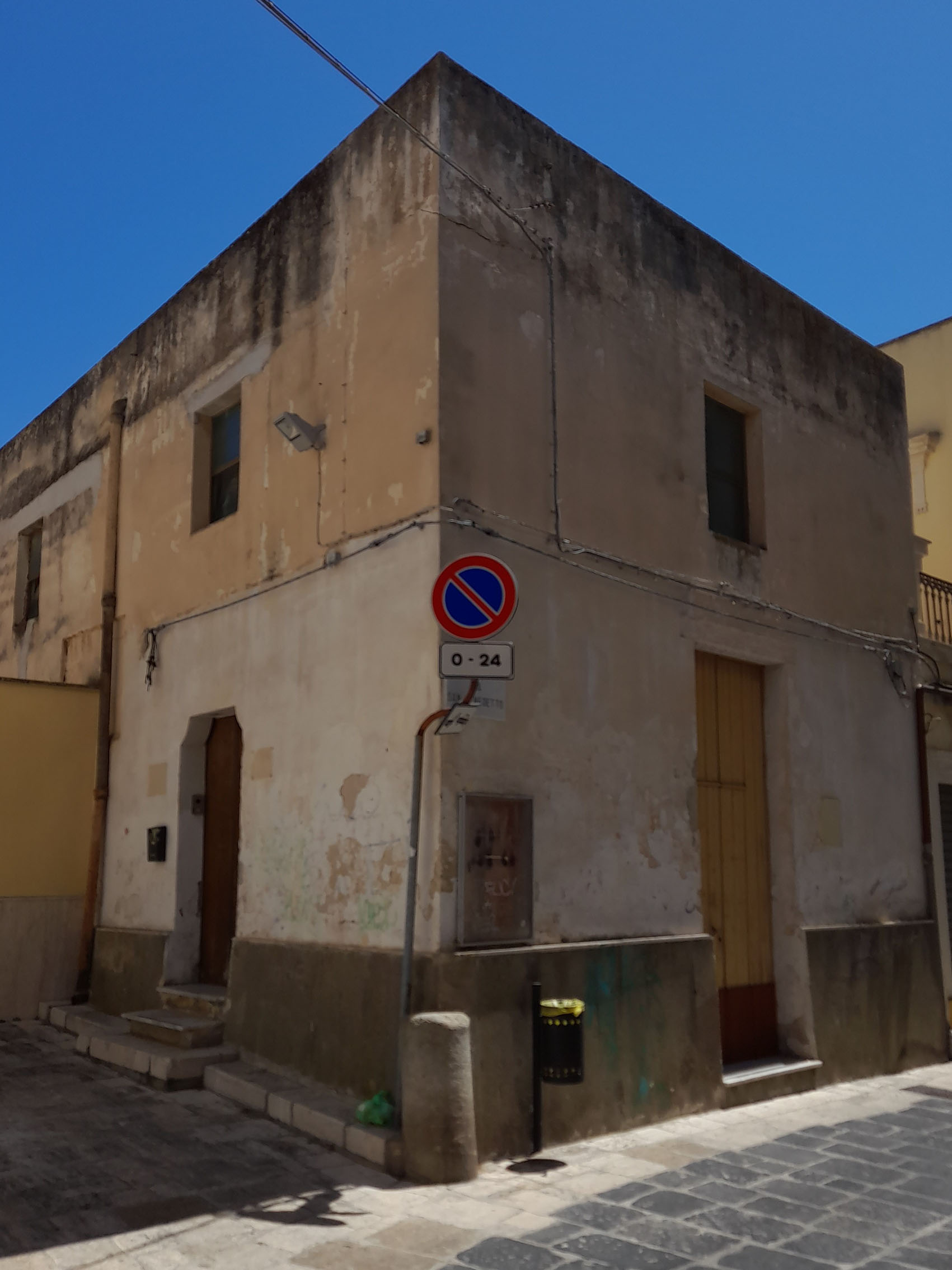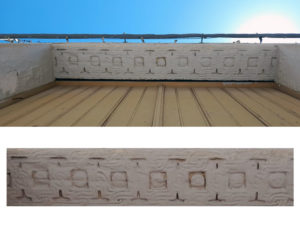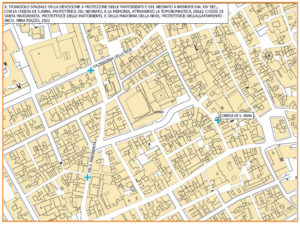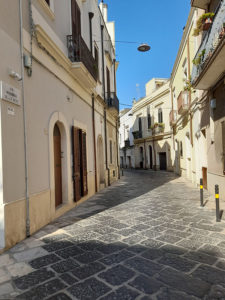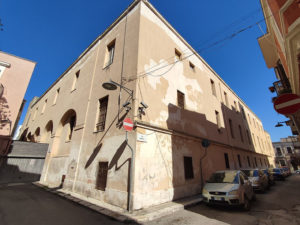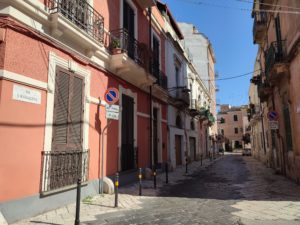Un triangolo di chiese
Chiesa di S. Anna, XIII sec., protettrice dei neonati, poco distante dalle chiese (non più esistenti) di S. Maria della Neve, protettrice dell’allattamento, e di S. Margherita, protettrice delle partorienti.
E’ questo uno dei luoghi emblematici della città; questa antica chiesa, che all’interno custodisce affreschi trecenteschi, versa in uno stato di fatiscenza ormai da decenni. Poco si sa della sua fondazione, ma il toponimo Sancta Anna risulta già in un documento del 1343 contenuto nel Codice Diplomatico Brindisino di Annibale De Leo.
Riferimenti continui e attendibili per la chiesa si hanno a partire dal 1565, quando risulta legato alla chiesa l’omonimo beneficio di jure patronato dell’ostunese famiglia Lazzari. Nel 1661 si resero necessari importanti lavori di ristrutturazione, che nel 1726 consentirono all’arcivescovo Andrea Maddalena di ubicare qui la sede di una delle nuove parrocchie vicariali, come riportato anche dal Camassa. Nel 1866 de jure e nel 1877 di fatto, la sede parrocchiale, pur conservando l’antico titolo, fu trasferita in San Benedetto, non più legata al monastero omonimo perché soppresso. Dal 2 maggio 1938 la chiesa venne chiusa al culto e da allora è stata oratorio, ospitando dapprima l’associazione dei Cavalieri dell’Ordine di Malta, poi altre associazioni sino a data odierna.
Nella parte superiore del portale d’ingresso è presente un architrave marmoreo, databile tra la fine dell’XI sec. e l’inizio del XII sec., proveniente verosimilmente dalla vicina chiesa di San Benedetto. La decorazione dell’intradosso (fig.1) è simile a quella, originale, della monofora posta sulla fiancata destra di San Benedetto e a quella del frammento di archivolto conservato nel Museo Provinciale e che proviene dalla stessa chiesa. Il lato esterno è decorato da pigne e palmette; l’intradosso da una serie di formelle quadrate composte da nastri intrecciati e includenti rosette.
All’interno della chiesa sul finire del XIX sec. furono rinvenuti degli affreschi, sui quali si è soffermata Benita Sciarra (1926 – 1993), archeologa e direttrice del Museo Archeologico di Brindisi, che così racconta: La serie di riquadri iconici (probabilmente attribuibile ad una unica fase decorativa) che attualmente ricopre le pareti del piccolo vano di accesso alla chiesa rivela un linguaggio che, pur legato alla tradizione bizantino-adriatica, già è informato dei più recenti fatti napoletani. Il ciclo non sarebbe perciò collocabile prima del Principato di Filippo d’Angiò (1294-1331) durante il quale Taranto diviene importante centro di attività artistica cui fanno capo Rinaldo (che a Brindisi firma il Giudizio Universale in Santa Maria del Casale) e Giovanni (conosciuto come Giovanni da Taranto), pittore operoso anche a Napoli la cui presenza è attestata in Puglia da un documento del 1304, alla cui attività la critica ha ricondotto gli affreschi della chiesa di Sant’Anna.
Il ciclo pittorico comprende una Madonna del Latte, in trono, che regge con il braccio sinistro il Bambino che allatta. L’affresco pone la chiesa di Sant’Anna come uno dei vertici di un triangolo devozionale legato alle problematiche del parto e della sopravvivenza del neonato nei primi mesi di vita, che si definiva in Santa Maria della Neve, o Madonna della Neve, e in Santa Margherita.
A Sant’Anna ci si doveva recare 40 giorni dopo il parto. Davanti a Santa Maria della Neve, chiesa poco distante da quella di S. Anna e citata dal Della Monaca tra le oltre 50 in rovina – la cui memoria è affidata alla toponomastica, con via Madonna della Neve, nonché ad un altarino in nicchia sulla facciata di una casa – era collocato un pozzo, il cui utilizzo sacrale continuò anche dopo la distruzione della chiesa, sull’orlo del quale sedevano le donne che temevano la perdita del latte; qui dovevano mangiare sette fette di pane inframezzando il pasto con la recita dell’Ave Maria. Santa Margherita era invocata dalle partorienti e a Brindisi, poco distante dalla chiesa di S. Anna – dove sono rappresentate in affresco anche le Storie di S. Margherita – vi era la chiesa di S. Margherita, che il Del Sordo ci dice andata in rovina già dal ‘600, ma la cui memoria anche qui è mantenuta dal toponimo dell’omonima via.
Ecco, quindi, che al triangolo devozionale legato al parto ed alla sopravvivenza del neonato, sviluppatosi in maniera significativa a partire dal XIV sec., trova riscontro un triangolo spaziale, con le tre chiese di S. Anna, S. Maria della Neve e S. Margherita distribuite nell’arco di poche centinaia di metri una dall’altra (fig.2), come fosse una infrastrutturazione devozionale del territorio a servizio delle donne in procinto di mettere al mondo una creatura.
E’ recente la volontà della Chiesa di Brindisi di istituire presso la chiesa di S.Anna l’antica Ruota degli esposti, per la cura dei neonati abbandonati, in continuità con la tradizione del luogo.
Note Bibliografiche:
– Bibliografia Sciarra, 1970, p. 102; Benita Sciarra, 1975
– Pasquale Camassa, Guida di Brindisi, ristampa a cura di AGM srl, Lecce, 1999
– Alberto Del Sordo, Toponomastica brindisina, il centro storico, Schena ed., Fasano (Br) 1990
– Giacomo Carito, Brindisi Nuova Guida, Ed. Prima 1993-4
– http://www.brindisiweb.it/arcidiocesi/chiese/brindisi/santanna.htm
A triangle of churches
Church of S. Anna, XIII century. Protectress of the infants. It is not far from the churches of S. Maria della neve, protectress of lactation, and of S. Margerita, protectress of pregnant women.
This is one of the most emblematic places of the city. This church cherishes frescoes from the XIV century, but it is in a state of decay since decades. There is few information about its foundation, but its toponymy, “Sancta Anna”, results in a document of 1343, part of the Annibale De Leo’s “Diplomatic Code of Brindisi”.
Continuous and reliable references to the church date back to 1565, when the homonymous benefit of “jure patronato” of the Lazzari family from Ostuni results tied to the church. In 1661 renovation works were needed. Once they were made, they allowed to the archbishop Andrea Maddalena to locate here the seat of one of the new vicar parishes, as Camassa reported. In 1866 de jure, and in 1877 de facto, the seat of the parish, albeit maintained the ancient title, was transferred to San Benedetto. San Benedetto church was no yet related to the homonymous monastery, because the latter was abolished. Since the 2nd of May 1938 the church was closed for worship and in has been converted into oratory. It hosted the association of the Knights of the Order of Malta, first, and other associations, then, until today.
On the upper part of the entrance portal there is a marble architrave, dated between the end of the XI century and the beginning of the XII century, likely coming from the near church of San Benedetto. The decoration of the intrados (fig. 1) is similar to the one of the single window situated on the right tide of San Benedetto. It is also similar to the one of the fragment of the archivolt cherished in the Provincial Museum, which came from the same church. The external side is decorated with pinecones and palmettes. The intrados is decorated with a series of square tiles, consisting of interwoven bands, which includes roses.
At the end of the XIX century, there were found frescoes inside the church. They were described by the archeologist and director of the Archeologic Museum of Brindisi, Benita Sciarra (1926 – 1993): the series of iconic tiles (likely attributable to a single decorative phase) currently cover the walls of the small compartment of access to the church. It reveals a language that, albeit related to the Adriatic-Byzantine tradition, it is influenced by the recent Neapolitans facts. The cycle, hence, is not datable before the Principate of Philip Anjou (1294-1331), during which Taranto became an important center for artistic activity. Rinaldo (the author of Last Judgement painted in the church of Santa Maria del Casale, in Brindisi) and Giovanni (known as Giovanni da Taranto) belong to this Period. Giovanni was a painter active also in Naples, whom presence in Puglia is proved by a document dated back to 1304, and to whom are attributed the frescoes of the church of Santa Anna.
The pictorial cycle includes a Madonna del Latte, enthroned, who holds the Child with her left arm, nursing him. The fresco represents the church of Santa Anna as one of the vertices of a devotional triangle, which the other two vertices are those of Santa Maria della Neve (also Madonna della Neve) and Santa Margherita. The triangle is related to the problems of the childbirth and to the survival of the infant in the first months of his life.
The pilgrimage had to be taken within 40 days after the childbirth. The memory of the existence of the church of Santa Maria della Neve, not far from the one of S. Anna and cited by Della Monaca among the more than 50 in ruins, is preserved by the toponymy, with the homonymous street and the altar sited in a niche on the façade of a house. In front of the church there was a pit, which sacral use continued even after the destruction of the church. Women who feared the loss of their milk used to sit on its edge. There, they must eat seven slices of bread, while reciting the Hail Mary. Saint Margaret was invoked by the parturient, and a church dedicated to her is located in Brindisi, not far from the church of Santa Anna (where there are frescoes representing the histories of S. Margaret). A. Del Sordo says that the church of S. Margherita was already ruined at the end of the XVII century, but its memory is still preserved by the toponymy of the homonymous street.
Therefore, a spatial triangle corresponds to the devotional one, developed since the XIV century. It consists of the three churches of S. Anna, S. Maria della Neve e S. Margherita, distributed in a range of few hundred of meters (fig. 2). It is like a devotional territorial infrastructure, at disposal of those women about to give birth.
Recently, the Church of Brindisi instituted the ancient “Ruota degli esposti” at the church of S. Anna, for the care of abandoned infants, evoking the traditions of that place.
Bibliographic notes:
– Bibliografia Sciarra, 1970, p. 102; Benita Sciarra, 1975
– Pasquale Camassa, Guida di Brindisi, ristampa a cura di AGM srl, Lecce, 1999
– Alberto Del Sordo, Toponomastica brindisina, il centro storico, Schena ed., Fasano (Br) 1990
– Giacomo Carito, Brindisi Nuova Guida, Ed. Prima 1993-4
– http://www.brindisiweb.it/arcidiocesi/chiese/brindisi/santanna.htm

